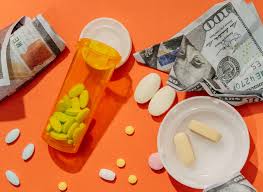
A new analysis by Ernst & Young, commissioned by the Pharmaceutical Research and Manufacturers of America, warns that a proposed 25 percent tariff on imported pharmaceuticals could saddle American consumers with an additional \$51 billion in drug expenses each year and potentially drive retail prices up by as much as 12.9 percent if fully passed through to end users ([US pharma tariffs would raise US drug costs by $51 billion annually, report finds](https://www.reuters.com/business/healthcare-pharmaceuticals/us-pharma-tariffs-would-raise-us-drug-costs-by-51-bln-annually-report-finds-2025-04-25/?utm_source=chatgpt.com)). In 2023, the United States imported \$203 billion in pharmaceutical goods—73 percent of which originated from Europe—with finished pharmaceutical sales in the domestic market totaling $393 billion.
The report highlights that around 30 percent of these imports are active ingredients for U.S. drug manufacturing, where tariffs could boost production costs by 4.1 percent and erode the global competitiveness of American-made medicines
Meanwhile, overall national spending on prescription drugs reached roughly \$450 billion in 2023, marking an 11.4 percent increase over the previous year .
Background on U.S. Pharmaceutical Trade and Spending
The United States remains the world’s largest pharmaceutical market, with total prescription drug expenditures climbing to \$393 billion in finished products in 2023. U.S. demand relies heavily on imports, valued at \$203 billion in 2023, sourced predominantly from Ireland, Germany, and Switzerland. In addition to finished medications, roughly $61 billion worth of imported chemical compounds and drug precursors fuel domestic manufacturing, accounting for about 30 percent of all pharmaceutical imports
U.S. export volumes are also substantial: American-made drugs worth \$101 billion were sold abroad in 2023, underpinning nearly half a million export-related jobs in the pharmaceutical sector. Overall U.S. prescription drug spending, which includes private insurance, government programs, and out-of-pocket payments, totaled \$449.7 billion in 2023, reflecting rising utilization and price trends . Meanwhile, list prices for brand-name drugs have grown faster than inflation, with single-source products seeing average increases of 7.4 percent and multi-source drugs rising 26.0 percent over the past year.
Projected Impact of 25 Percent Tariffs
Under a 25 percent levy scenario, total annual U.S. drug spending could jump by nearly \$51 billion, equivalent to a price increase of up to 12.9 percent for end consumers if the full cost is transferred through supply. For a typical household with annual prescription expenses of \$1,500, this could translate to an extra \$193 per year on medicine alone . High-cost specialty therapies—many priced in the tens of thousands of dollars—would see even larger absolute increases, further straining patients with chronic or life-threatening conditions. Wholesale and retail distributors would face higher import duties on finished products, likely driving up pharmacy acquisition costs and, ultimately, insured copays and uninsured out-of-pocket charges.
Meanwhile, tariffs on intermediate chemical imports could push up manufacturing costs by 4.1 percent, discouraging domestic facilities from expanding production and undermining attempts to onshore drug manufacturing.
Consequences for Consumers and Public Health
Rising drug prices risk reducing adherence to prescribed regimens, particularly among older adults and low-income patients already facing high out-of-pocket burdens. Per-capita out-of-pocket spending peaked at \$157 in 2023 and is projected to decline only if policy interventions target cost-sharing; tariffs would reverse any anticipated relief. Insured patients may hit benefit caps sooner, shifting more costs onto Medicare, Medicaid, or private payers, which ultimately could drive insurance premiums higher for all enrollees. Under Medicare Part D, patients without low-income subsidies already average $3,355 in annual drug costs, and a tariff-induced price hike could push millions past catastrophic thresholds more quickly . The proposed tariffs also threaten access to essential generic medicines, where price increases of even a few dollars per prescription can lead to rationing or delayed refills.
Industry, Lobbying, and Regulatory Responses
President Trump has repeatedly threatened 25 percent tariffs on drug imports to promote domestic manufacturing and address national security concerns over foreign production dependencies. In April 2025, the Commerce Department opened a Section 232 investigation into the national security implications of pharmaceutical imports, triggering a 21-day comment period for industry input . Major drugmakers, including Roche, Pfizer, and Amgen, have lobbied for phased implementation or narrow exemptions for critical drugs, arguing that tariffs would disrupt supply chains and delay patient access to life-saving.
PhRMA officials have emphasized that targeted tariff relief for intermediate inputs could be a more effective strategy to bolster domestic production without penalizing. Congressional leaders from both parties have voiced concerns over the potential cost impact on constituents, with some lawmakers calling for automatic exemptions for drugs essential to public health.
Potential Mitigation and Policy Alternatives
Experts suggest several policy options to mitigate tariff-driven cost increases, including exemptions for active pharmaceutical ingredients and finished medicines under national security provisions. Expanding tax credits or grants for domestic API production could incentivize onshoring without directly raising consumer prices. Accelerated FDA review for domestically produced generics and biologics might lower production costs over time and reduce import reliance. Implementing out-of-pocket caps—such as the $2,000 annual cap under Medicare Part D set to take effect in 2025—can shield seniors from tariff-induced spikes, although broader applicability to commercial plans would require legislative action. Policymakers could also lean on trade partners for mutual recognition agreements to secure affordable access to essential drugs while maintaining supply-chain integrity .
The proposed 25 percent tariffs on pharmaceutical imports present a stark choice between bolstering domestic manufacturing and risking substantial price hikes for U.S. patients. While industry and some policymakers underscore the national security rationale for reducing import dependencies, the estimated \$51 billion annual cost burden and up to 12.9 percent price increases could imperil patient access and exacerbate public health disparities. Targeted exemptions for critical medicines and inputs, coupled with incentives for onshore production and consumer-protection mechanisms like out-of-pocket caps, offer a pathway to reconcile industrial goals with patient affordability. As the Section 232 investigation unfolds and stakeholder comments accumulate, the final policy mix will determine whether the U.S. achieves a sustainable balance between supply-chain security and medicine affordability.
(Source:www.reuters.com)
The report highlights that around 30 percent of these imports are active ingredients for U.S. drug manufacturing, where tariffs could boost production costs by 4.1 percent and erode the global competitiveness of American-made medicines
Meanwhile, overall national spending on prescription drugs reached roughly \$450 billion in 2023, marking an 11.4 percent increase over the previous year .
Background on U.S. Pharmaceutical Trade and Spending
The United States remains the world’s largest pharmaceutical market, with total prescription drug expenditures climbing to \$393 billion in finished products in 2023. U.S. demand relies heavily on imports, valued at \$203 billion in 2023, sourced predominantly from Ireland, Germany, and Switzerland. In addition to finished medications, roughly $61 billion worth of imported chemical compounds and drug precursors fuel domestic manufacturing, accounting for about 30 percent of all pharmaceutical imports
U.S. export volumes are also substantial: American-made drugs worth \$101 billion were sold abroad in 2023, underpinning nearly half a million export-related jobs in the pharmaceutical sector. Overall U.S. prescription drug spending, which includes private insurance, government programs, and out-of-pocket payments, totaled \$449.7 billion in 2023, reflecting rising utilization and price trends . Meanwhile, list prices for brand-name drugs have grown faster than inflation, with single-source products seeing average increases of 7.4 percent and multi-source drugs rising 26.0 percent over the past year.
Projected Impact of 25 Percent Tariffs
Under a 25 percent levy scenario, total annual U.S. drug spending could jump by nearly \$51 billion, equivalent to a price increase of up to 12.9 percent for end consumers if the full cost is transferred through supply. For a typical household with annual prescription expenses of \$1,500, this could translate to an extra \$193 per year on medicine alone . High-cost specialty therapies—many priced in the tens of thousands of dollars—would see even larger absolute increases, further straining patients with chronic or life-threatening conditions. Wholesale and retail distributors would face higher import duties on finished products, likely driving up pharmacy acquisition costs and, ultimately, insured copays and uninsured out-of-pocket charges.
Meanwhile, tariffs on intermediate chemical imports could push up manufacturing costs by 4.1 percent, discouraging domestic facilities from expanding production and undermining attempts to onshore drug manufacturing.
Consequences for Consumers and Public Health
Rising drug prices risk reducing adherence to prescribed regimens, particularly among older adults and low-income patients already facing high out-of-pocket burdens. Per-capita out-of-pocket spending peaked at \$157 in 2023 and is projected to decline only if policy interventions target cost-sharing; tariffs would reverse any anticipated relief. Insured patients may hit benefit caps sooner, shifting more costs onto Medicare, Medicaid, or private payers, which ultimately could drive insurance premiums higher for all enrollees. Under Medicare Part D, patients without low-income subsidies already average $3,355 in annual drug costs, and a tariff-induced price hike could push millions past catastrophic thresholds more quickly . The proposed tariffs also threaten access to essential generic medicines, where price increases of even a few dollars per prescription can lead to rationing or delayed refills.
Industry, Lobbying, and Regulatory Responses
President Trump has repeatedly threatened 25 percent tariffs on drug imports to promote domestic manufacturing and address national security concerns over foreign production dependencies. In April 2025, the Commerce Department opened a Section 232 investigation into the national security implications of pharmaceutical imports, triggering a 21-day comment period for industry input . Major drugmakers, including Roche, Pfizer, and Amgen, have lobbied for phased implementation or narrow exemptions for critical drugs, arguing that tariffs would disrupt supply chains and delay patient access to life-saving.
PhRMA officials have emphasized that targeted tariff relief for intermediate inputs could be a more effective strategy to bolster domestic production without penalizing. Congressional leaders from both parties have voiced concerns over the potential cost impact on constituents, with some lawmakers calling for automatic exemptions for drugs essential to public health.
Potential Mitigation and Policy Alternatives
Experts suggest several policy options to mitigate tariff-driven cost increases, including exemptions for active pharmaceutical ingredients and finished medicines under national security provisions. Expanding tax credits or grants for domestic API production could incentivize onshoring without directly raising consumer prices. Accelerated FDA review for domestically produced generics and biologics might lower production costs over time and reduce import reliance. Implementing out-of-pocket caps—such as the $2,000 annual cap under Medicare Part D set to take effect in 2025—can shield seniors from tariff-induced spikes, although broader applicability to commercial plans would require legislative action. Policymakers could also lean on trade partners for mutual recognition agreements to secure affordable access to essential drugs while maintaining supply-chain integrity .
The proposed 25 percent tariffs on pharmaceutical imports present a stark choice between bolstering domestic manufacturing and risking substantial price hikes for U.S. patients. While industry and some policymakers underscore the national security rationale for reducing import dependencies, the estimated \$51 billion annual cost burden and up to 12.9 percent price increases could imperil patient access and exacerbate public health disparities. Targeted exemptions for critical medicines and inputs, coupled with incentives for onshore production and consumer-protection mechanisms like out-of-pocket caps, offer a pathway to reconcile industrial goals with patient affordability. As the Section 232 investigation unfolds and stakeholder comments accumulate, the final policy mix will determine whether the U.S. achieves a sustainable balance between supply-chain security and medicine affordability.
(Source:www.reuters.com)














